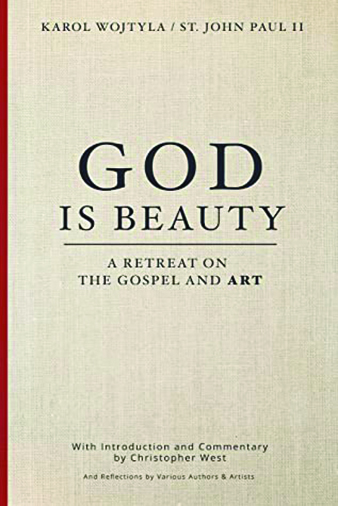In ‘God is Beauty,’ John Paul II makes clear each of us are artists of our own lives

Book Review / By Lindsey Weishar
The first book to come out of Christopher West’s new Theology of the Body Institute Press is a delightful read called “God is Beauty: A Retreat on the Gospel and Art.”
The book begins with a never-before-translated retreat that Karol Wojtyla (before he was Pope John Paul II) gave to a group of artists during Holy Week of 1962. Broken into five lessons, Wojtyla reflects on the artistic vocation and the Gospel as “a wellspring of inspiration that never dries up.”
As an artist, this book has provided me with a touchpoint for artistic expression as a Catholic. But more, it reveals the incomparability of the human person as God’s masterwork within creation. I heartily recommend giving this book a read; it is one to which I will return to continue gathering its treasures.
Before diving in to a few tidbits from the retreat that particularly stood out to this reader, it’s important to note that the book itself is a collection of artistic inspiration. Utilizing the retreat as its source, part of the book is dedicated to West’s commentary on the retreat in light of John Paul II’s “Theology of the Body.” What follows are the voices of various artists and theologians, each of whom dive more deeply into one of the five lessons. The result is akin to artistic collaboration–increased appreciation and understanding of this retreat.
“WHAT HAVE I MADE OF MYSELF?”
Even if you’re not an artist, this book is for you. In Lesson Three, Wojtyla makes clear that each of us are the artists of our own lives: “In the face of God’s judgment, any of a person’s works — even those of the greatest artist — do not substitute for the person. What decides and determines this is the one fundamental work, which is my own self. What have I made of myself? And what have I done with myself?”
Especially in modern American culture, where the results of our work are often valued more than the person who makes them, this is an incredibly important point. We have been entrusted with the sacred duty of tending to the life we’ve been given.
As Byzantine Catholic priest Father Thomas Loya puts it in his reflection on Lesson Three, “what distinguishes the human person from all other creatures on earth is that the human person alone is made for liturgy, for worship. We alone can ‘offer.’” We are called to make our lives a gift.
“A STREAM OF BEAUTY”
Another part of Wojtyla’s retreat that really struck me is a quote he mentions from poet Zymunt Krasiński: “A stream of Beauty flows through you, but you yourself are not Beauty.” Capital-B Beauty refers to God, and though the artist can create beautiful works, God is the supreme Creator.
Wojtyla speaks to this relationship between Creator and artist when he discusses artistic ability:
It is a gift of the Creator — a difficult gift, a gift for which one must pay one’s entire life. ‘It’s a gift that births a very great responsibility: I am responsible for my talent. I cannot bury it, because it will have the fate of the proverbial talent that was “buried” in the Gospel . . . .’
The idea is for the person gifted with talent to create works of art, to incarnate Beauty, and in creating these works, to incarnate Beauty so that it serves others.
In his commentary, Christopher West points out Wojtyla’s invitation to artists to the necessary interior work that allows the stream of Beauty full reign in the artist’s life: “We ‘must find a time and a place’ for this interior work in our lives and not substitute exterior works of art for this more essential (most essential) interior work of art. Do my exterior works of creativity hamper me in the interior work of developing my own humanity?” What a piercing question!
Musician Mike Magione taps into this question by sharing the story of growth as an artist and the stream of Beauty flowing through him: “Using my gifts for anything other than directing people toward the source diminishes my artistic purpose and the quality of my work . . . One must create with the disposition of ‘not I but He’ in order to achieve the proper telos. This is the difference between the idol and the icon.”
GOD’S MASTERWORK
Artist and professor, Dr. Sarah Maple, whose chapter on Lesson Five (titled “Prayer: Sustaining the Interior Life of the Artist”) was my personal favorite for its depth and beauty, adds to the idea that the artist gives of him/herself from the stream of Beauty by reminding readers that Beauty Himself pursues all of us, and that “[t]he task of the artist is to formulate creation further in a cooperative union with God’s creative love, and in doing so reveal the meaning of man’s existence to himself.” Drawing from John Paul II’s “Letter to Artists,” she goes on to say that artists of faith have the “special task” of revealing the redemption of the person and the world in Christ.
As an artist, this book has provided me with a touchpoint for artistic expression as a Catholic. But more, it reveals the incomparability of the human person as God’s masterwork within creation. I heartily recommend giving this book a read; it is one to which I will return to continue gathering its treasures.
—
 LINDSEY WEISHAR is a poet, freelance writer, and native of Champaign who has a master of fine arts in creative writing from the University of Missouri-Kansas City. She is executive assistant to the president at Donnelly College in Kansas City, Kansas. Write to her at lweisharwriting@gmail.com.
LINDSEY WEISHAR is a poet, freelance writer, and native of Champaign who has a master of fine arts in creative writing from the University of Missouri-Kansas City. She is executive assistant to the president at Donnelly College in Kansas City, Kansas. Write to her at lweisharwriting@gmail.com.





